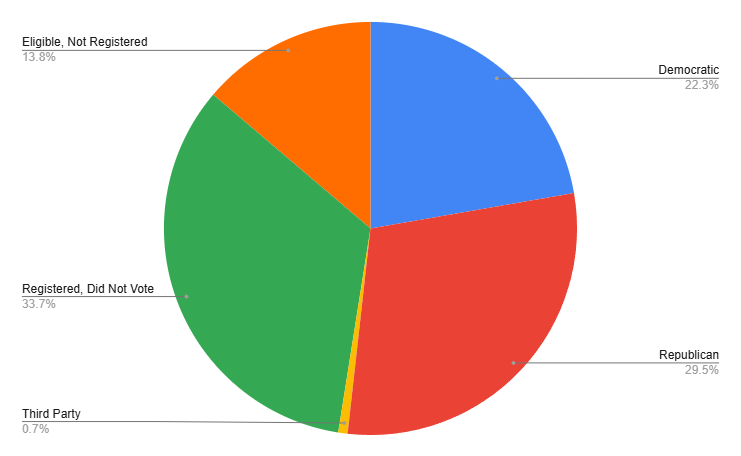For years, I’ve held this belief and written about how appealing to the moderate voter was a mistake. During the Democratic primaries earlier this year, I endorsed the most progressive candidate for the US Senate. At that time, I shared with Lone Star Left readers that the progressive candidate would appeal better to Texas voters than the more moderate options. However, the more moderate candidate won the primary, and I got behind him because of unity.
People on social media, left and right, were messaging me about how they knew so many Republicans who would “crossover” and vote for the Democrats because the common sense GOP members would reject Trumpism. Then there was Liz Cheney, Adam Kinzinger, and Republicans for Kamala Harris.
When my Conservative dad said he was writing in Nikki Haley and voting for Allred over Cruz, I bought into the hype, even though I remained skeptical.
It was all hype. Joe Biden got more “crossover” votes than Kamala Harris.
From exit polls in 2020, 6% of Republicans voted for Biden.
From the 2024 exit polls, Kamala Harris had 5% of Republicans voting for her.
So, all that hype about how Republicans would vote for Democrats in unprecedented numbers was just hype—and even I fell for it. All of that pandering to the center, and Republicans wound up being all for nothing. It didn’t gain any Republican votes but likely alienated the progressives.
Of course, the ideology swing wasn’t the only reason for the loss here in Texas, but I believe it had a big part. I’ll explain why.
How do we know that Texas Democrats lean further left of liberals (i.e., progressive)?
If you are a regular voter and vote down the ballot, you’ve likely cast a vote for your local precinct chairs and county chairs. These are the people that Democratic voters in Texas choose to represent their neighborhoods and their counties. Every two years, your county Democratic Party has a convention. At that convention, they submit, debate upon, and pass (or vote down) rules, resolutions, and platform planks and decide who will be the county’s representative at the state convention.
Then, at the state convention, delegates from every corner of Texas vote on the State Party’s platforms, rules, and documents guiding its operations.
Earlier this year, the Texas Democratic Party passed the most progressive party platform in the nation. This was a fair, transparent, and inclusive process; this is how we know what Texas Democratic voters want.
If you don’t know the difference:
Liberal Democrat: More moderate, willing to unite across the political spectrum to appeal to centrists. Supports incremental changes to the system, seeking gradual shifts to compromise with opposing viewpoints. Policies aim for bipartisan and moderate support.
Progressive Democrat: Feels like moving to the center dilutes values and policies that would improve people’s lives. Pushes for transformative policies directly addressing systematic issues (i.e., universal healthcare, aggressive climate action, strong economic and racial justice stances, etc.).
Of course, there is nothing wrong with being a Liberal or even a Centrist, but it’s really about where you stand on policy and how to get there. And we know that Texas Democrats are among the most progressive in the nation. They reflect the values of local Democratic voters who push for a platform focused on bold, systemic changes rather than centrism.
We all belong under the Democratic Umbrella, and even if we differ in policy, we must be realistic about what motivates would-be Democratic voters in Texas.
Why did that matter in this election?
While Kamala Harris and Tim Walz both had solid progressive records, for this election, they moved right. They ran on the right of the border issue. They ran on the right of the Palestine/Israel war.
Both Kamala Harris and Colin Allred ran for Conservative policy regarding the border. Here is what the Texas Democratic Party platform says (paraphrased):
Texas Democrats advocate for comprehensive immigration reform that supports families, communities, and the economy. They prioritize local input and humane treatment and oppose politicized stunts. Key policies include a path to citizenship, visa reform for families, students, and workers, abolishing reentry bans for non-violent applicants, increasing asylum access, and reducing visa barriers. They reject discriminatory laws and support equal access to education, healthcare, housing, and driver’s licenses for immigrants. Texas Democrats aim to demilitarize border policing, maintain local law enforcement’s independence from ICE, and foster economic opportunities in Latin America to reduce migration pressures.
Aside from that, the Texas Democratic Party was the first state to call for a ceasefire, a two-state solution for Palestine, and an arms embargo on Israel. This harmed both Harris and Allred with Texas Democrats.
But how do we know? Let’s look at the data:

Democrats in Texas lost votes in 2024 compared to 2020, and a record 7.3 million people stayed home. The turnout in blue counties and the counties that should have turned blue was abysmal.
Dallas County saw a 57.18% turnout in a presidential election, their lowest turnout since 2004.
Harris County Democrats aimed to turnout out 1.1 million Democratic voters this year. They only made it to 802K… They were at 911K in 2020.
Travis County saw a 63.65% turnout, which is also their lowest since 2004.
None of the border counties we lost even hit a 50% turnout.
In Texas this year, Democrats stayed home.
As a result, after countless cycles of ticking left, Texas moved right.
2012: R - 57.17% / D - 41.38% (15 points)
2016: R - 52.23% / D - 43.24% (9 points)
2020: R - 52.06% / D - 46.48% (5 points)
2024: R - 56.22% / D - 42.38% (13 points)
And, how do 2024 voters look in one pie?
That’s just the registered voters.
I’m a little nervous about posting the next pie, which includes eligible but not registered voters. But we have to see it.
The fact of the matter is that Democrats and would-be Democrats stayed home. Is the shift at the top of the ticket the reason for this?
What do you think?
You might have heard in the media that the entire country has moved right, and somehow, this was inevitable because of the presidential choices. But I want to point you to a few other states:
Arizona: Trump won, but down-ballot Ruben Gallego (D) won his Senate seat.
Nevada: Trump won, but down-ballot Jacky Rosen (D) won his Senate seat.
North Carolina: Trump won, but Democrats saw big gains down the ballot, including the Governor, Lt. Governor, and Attorney General.
My point is that the Democratic shift to the center, especially on critical issues like immigration and foreign policy, didn’t pay off in Texas, especially down-ballot, as it did in other states. Despite predictions that centrist moves would attract moderate or crossover Republican voters, the turnout data shows that this strategy likely alienated the progressive base without gaining significant Republican support.
Low turnout in historically Democratic areas and the 2024 point swings suggest that a more progressive platform, as embraced by Texas Democrats, might have better energized voters. Furthermore, states like Arizona, Nevada, and North Carolina show that Democrats can still win down-ballot races even when a Republican tops the ticket. This evidence challenges the notion that moving right is necessary to secure votes in traditionally conservative states.
Is that the only reason?
Not even close.
In America, approximately 54% of American adults read below a sixth-grade level, with nearly one in five reading below a third-grade level.
From the NBC News Exit Poll in Texas:
The most critical data set is misinformation works. Those who believed misinformation voted for Trump, while those who believed the truth voted for Harris.
Republicans have a well-oiled propaganda machine that spans all media platforms, and we do not. Period.
You may have already heard the talking heads discussing this: how Republicans have podcasts, talk radio, news aggregator apps, massive social media influencers, and a billion online publications.
Republicans have built an extensive media ecosystem that spans various platforms, significantly influencing public opinion. They use those ecosystems to spread massive amounts of disinformation to millions. They’re beating us there.
So, what do we do about it?
After this election, many more people have become acutely aware of the problem and are looking for solutions. Democrats need their own media ecosystem, but that is a topic for another day.
So…what happened, Texas?
The candidates at the top of the ticket veered right, losing appeal to the more progressive Democratic voter.
Many voters didn’t understand the repercussions of voting for Trump (i.e., what is authoritarianism?).
The Republican media ecosystem has taken one-third of our population out of reality.
The Texas Democratic Party hasn’t built a robust infrastructure to sustain a state campaign as big as Texas. (But, we’re moving forward.)
Texas Democrats face a crossroads. This election made it clear that shifting to the center alienates the progressive base while failing to attract significant crossover support from Republicans. The state’s progressive platform aligns with Texas Democratic values, but without a well-developed media presence to counter Republican narratives and a robust, state-wide infrastructure, even the best candidates struggle to reach and energize voters.
To turn Texas blue, we need a progressive agenda that genuinely speaks to the issues Texans face, paired with a powerful media ecosystem to tell our story, combat disinformation, and connect with the people. The path forward is clear: we need to invest in grassroots infrastructure, stay true to our progressive values, and work relentlessly to build our own network to inform, engage, and inspire Texas voters.
We may have lost the battle, but the war is far from over.
LoneStarLeft’s Newsletter is a reader-supported publication. To receive new posts and support my work, consider becoming a free or paid subscriber.
Follow me on Facebook, TikTok, Threads, YouTube, and Instagram.












Do you think voter suppression and intimidation had anything to do with this in Texas? I don't live in your state and you are the master of what goes on there, I'm just an outsider that reads you- but I wonder if the tyrannical workings of Ken Paxton scared people.
Where does racism and misogyny fit in here- because I actually think those are the top two issues.
The most *consequential* election of our lifetime and Democrats stayed home just because they're upset that Harris floated too far to the middle. I'm struggling with that one. Nothing like cutting off your nose to spite your face. But then again I have seen a few comments from the far left who are super pissed at AOC for supporting Harris.
Perhaps I'm overly pragmatic, but step 1 is to save democracy, that means vote for Harris - Step 2 is to move the party from the middle to the left.
The Overton Window is completely fucked now, we will not get back to the middle in my lifetime, I'm 55.
I don't know when I'll get out of my grieving process, and right now I'm full of rage and hate for the Trump voters and the none voters. But they will find out soon enough what they bought..... because the Republican gestapo started taking their masks off already on Wednesday.
Here's a joke going around Germany, "what borders stupidity? Mexico and Canada."